CoBank: Beef on dairy brings new value to marketplace
More dairies expected to incorporate beef breed genetics for additional revenue stream.
August 25, 2023

The U.S. beef cow herd reached its lowest level in decades this summer as prolonged drought conditions in major cattle producing regions led producers to aggressively cull their herds. The sharp reduction in beef cow numbers will tighten supplies for years to come, while consumer demand for beef has remained remarkably consistent despite elevated retail prices.
The contracting beef herd has led to higher dairy bull calf prices and may compel more dairy producers to leverage beef breed genetics in their reproduction programs and capture an additional revenue stream in the process, according to a new report from CoBank’s Knowledge Exchange.
“We expect the adoption of beef genetics in dairy breeding programs will accelerate as producers capitalize on the opportunity for improved margins, particularly given the reduction in beef calf availability,” said Brian Earnest, lead animal protein economist for CoBank. “And while the impact on the overall beef supply will be relatively small, an increase in beef and dairy crossbred calves entering the beef supply chain is something cattle feeders and packers will want to keep an eye on.”
The practice of leveraging beef genetics in dairy reproductive programs, commonly referred to as “beef on dairy” within the industry, has steadily increased in recent years. On average, day-old beef and dairy crossbred calves entering the beef supply chain sell for $100-$300 more than their 100% dairy-bred counterparts.
Increased adoption of beef on dairy crossbreeding will primarily benefit dairy producers, but other sectors of the beef supply chain stand to benefit as well. Animal genetics companies that provide beef semen for artificial insemination of dairy cows can expect continued sales growth.
According to the National Association of Animal Breeders’ Semen Sales Report, U.S. beef semen sales from 2017 to 2022 increased at a rate nearly equal to the rate that U.S. dairy semen sales decreased. The data suggests rising beef semen sales are largely attributable to increased purchases by dairy operators.
Increased feed efficiency
The benefits from beef on dairy crossbreeding become more complex as calves enter the feedlot. Cattle feeders that are currently set up to handle 100% dairy cattle may see increased feed efficiencies for crossbred calves and would likely be more willing to pay the premium price for beef on dairy genetics.
Industry experts suggest feed efficiency gains in beef and dairy crossbred calves can be highly variable. A University of Wisconsin extension report notes that is why some feedlots are taking a direct approach with dairies to acquire more consistent crossbred calves by offering purchase programs for beef on dairy calves. These programs typically require dairy producers use genetics selected or provided by the feedlot, as well as follow specific animal health protocols.
The investment in those feedlot programs can ultimately pay off. Data from the USDA’s Cattle Contracts library shows beef on dairy cattle are worth increasingly more at harvest compared to straight-bred dairy cattle. And in addition to facing fewer discounts than straight-bred dairy cattle, crossbred cattle can garner an average premium of $5.44/cwt. if they meet the 10 requirements for Certified Angus Beef.
Like feedlots, packers already processing dairy cattle or lower quality 100% beef cattle will see a benefit in processing beef and dairy crossbreds, which generally have a better dressing percentage. However, for packers that process high-quality, 100% beef cattle, the benefits are less clear. Standard grading mechanisms may not be sufficiently sophisticated to properly value beef on dairy cattle.
The full report can be accessed here.
You May Also Like


.png?width=300&auto=webp&quality=80&disable=upscale)
